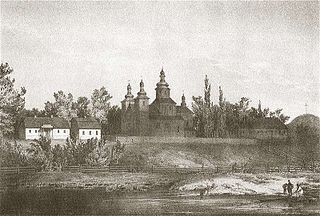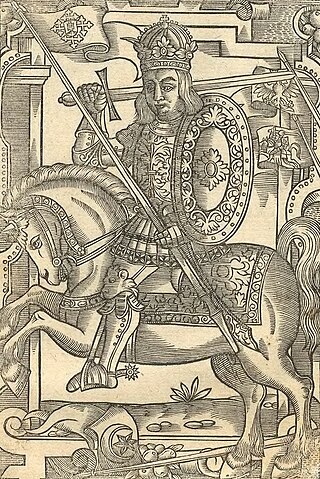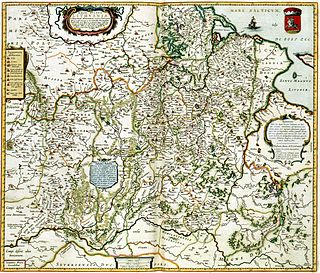
The Grand Duchy of Lithuania was a European state that existed from the 13th century to the late 18th century, when the territory was partitioned in 1795 among the Russian Empire, the Kingdom of Prussia, and the Habsburg Empire of Austria. The state was founded by Lithuanians, who were at the time a polytheistic nation born from several united Baltic tribes from Aukštaitija.

The Pact of Vilnius and Radom was a set of three acts passed in Vilnius, Grand Duchy of Lithuania, and confirmed by the Crown Council in Radom, Kingdom of Poland in 1401. The union amended the earlier act of the Union of Krewo (1385) and confirmed the Ostrów Agreement (1392). Vytautas, Grand Duke of Lithuania, became fully in charge of the Lithuanian affairs, while Władysław II Jagiełło, King of Poland, reserved the rights of an overlord. After the death of Vytautas, Lithuania was to be ruled by Władysław II Jagiełło or his legal heir. The union is generally seen as strengthening of the Polish–Lithuanian union.
The Act of Mielnik or Union of Mielnik was an attempt to unite the Kingdom of Poland with the Grand Duchy of Lithuania in 1501. It was not ratified by the Lithuanian Seimas or by the Polish Sejm. The Act of Mielnik remained just a political project. Despite the failure to unify two countries into a single state, Poland and Lithuania were under a personal union until the Union of Lublin of 1569.
Voruta may have been the capital city of the Grand Duchy of Lithuania and the Kingdom of Lithuania during the reign of king Mindaugas in the 13th century. Voruta is mentioned briefly in a written source only once and its exact location is unknown. Despite all the uncertainties, the concept of Voruta is well-known and popular in Lithuania.

Vaišvilkas or Vaišelga was the Grand Duke of Lithuania (1264–1267). He was son of Mindaugas, the first and only Christian King of Lithuania.

The Treaty of Melno or Treaty of Lake Melno was a peace treaty ending the Gollub War. It was signed on 27 September 1422, between the Teutonic Knights and an alliance of the Kingdom of Poland and the Grand Duchy of Lithuania at Lake Melno, east of Graudenz (Grudziądz). The treaty resolved territorial disputes between the Knights and Lithuania regarding Lithuania Minor and Samogitia, which had dragged on since 1382, and determined the Prussian–Lithuanian border, which afterwards remained unchanged for about 500 years. A portion of the original border survives as a portion of the modern border between the Republic of Lithuania and Kaliningrad Oblast, Russia, making it one of the oldest and most stable borders in Europe.

The Kingdom of Lithuania was a Lithuanian state, which existed roughly from 1251 to 1263. King Mindaugas was the first and only Lithuanian monarch crowned King of Lithuania with the assent of the Pope. The formation of the Kingdom of Lithuania was a partially successful attempt at unifying all surrounding Baltic tribes, including the Old Prussians, into a single state.
The Battle of Skuodas or Schoden was a medieval battle fought in ca. 1259 near Skuodas in present-day Lithuania during the Lithuanian Crusade. The Samogitian army of 3,000 invaded Courland and on their way back defeated the Livonian Order, killing 33 knights and many more low-rank soldiers. In terms of knights killed, it was the eighth largest defeat of the Livonian Order in the 13th century. This victory led to a Semigallian insurrection against the Livonian crusaders, which lasted from 1259 to 1272.

The Battle of Durbe was a medieval battle fought near Durbe, 23 km (14 mi) east of Liepāja, in present-day Latvia during the Livonian Crusade. On 13 July 1260, the Samogitians soundly defeated the joint forces of the Teutonic Knights from Prussia and Livonian Order from Livonia. Some 150 knights were killed, including Livonian Master Burchard von Hornhausen and Prussian Land Marshal Henrik Botel. It was by far the largest defeat of the knights in the 13th century: in the second-largest, the Battle of Aizkraukle, 71 knights were killed. The battle inspired the Great Prussian Uprising and the rebellions of the Semigallians, the Couronians, and the Oeselians. The battle undid two decades of Livonian conquests and it took some thirty years for the Livonian Order to restore its control.
Edvardas Gudavičius was a Lithuanian historian. He was known as one of the best historians in Lithuania specializing in the early history of Grand Duchy of Lithuania and is an author of many publications.

The first known record of the name of Lithuania is in a 9 March 1009 story of Saint Bruno recorded in the Quedlinburg Chronicle. The Chronicle recorded a Latinized form of the Old Church Slavonic word for Lithuania — Литъва — Latinized as Litva. Although it is clear the name originated from a Baltic language, scholars still debate the meaning of the word.
The Union of Kraków and Vilna also known as Union of Vilnius was one of the agreements of the Polish–Lithuanian union. It was signed in Kraków by Polish nobility on 6 May 1499 and in Vilnius by Lithuanian nobility on 24 July 1499.
The Battle of Blue Waters was a battle fought at some time in autumn 1362 or 1363 on the banks of the Syniukha river, left tributary of the Southern Bug, between the armies of the Grand Duchy of Lithuania and the Golden Horde. The Lithuanians won a decisive victory and finalized their conquest of the Principality of Kiev.

Leičiai were a distinct social group of the Lithuanian society in the early Grand Duchy of Lithuania subordinate to the Lithuanian ruler or the state itself. Leičiai were native to the Lietuva Land and formed the core of the Lithuanian society in the pre-state era and during the establishment of the state. Leičiai made up the majority of the military-economic staff of the state: they enforced state authority in the periphery, protected state borders, and performed various other war-related functions, such as breeding riding horses. By the 15th and 16th centuries, leičiai were in decline, already losing some of their functions and prestige, and they disappeared as a social class after the implementation of the Wallach Reform.

Mindaugas is the first known Grand Duke of Lithuania and the only crowned King of Lithuania. Little is known of his origins, early life, or rise to power; he is mentioned in a 1219 treaty as an elder duke, and in 1236 as the leader of all the Lithuanians. The contemporary and modern sources discussing his ascent mention strategic marriages along with banishment or murder of his rivals. He extended his domain into regions southeast of Lithuania proper during the 1230s and 1240s. In 1250 or 1251, during the course of internal power struggles, he was baptised as a Roman Catholic; this action enabled him to establish an alliance with the Livonian Order, a long-standing antagonist of the Lithuanians. By 1245, Mindaugas was already being referred to as "the highest king" in certain documents. During the summer of 1253 he was crowned King of Lithuania, ruling between 300,000 and 400,000 subjects.

The history of Lithuania between 1219 and 1295 concerns the establishment and early history of the first Lithuanian state, the Grand Duchy of Lithuania. The beginning of the 13th century marks the end of the prehistory of Lithuania. From this point on the history of Lithuania is recorded in chronicles, treaties, and other written documents. In 1219, 21 Lithuanian dukes signed a peace treaty with Galicia–Volhynia. This event is widely accepted as the first proof that the Baltic tribes were uniting and consolidating. Despite continuous warfare with two Christian orders, the Livonian Order and the Teutonic Knights, the Grand Duchy of Lithuania was established and gained some control over the lands of Black Ruthenia, Polatsk, Minsk, and other territories east of modern-day Lithuania that had become weak and vulnerable after the collapse of Kievan Rus'.

Vykintas Vaitkevičius is a Lithuanian archaeologist.
The siege of Smolensk was an unsuccessful attempt to capture Smolensk by the forces of the Grand Duchy of Moscow in summer 1502. It was the last major military engagement during the Muscovite–Lithuanian War (1500–1503).

Litvinism is a branch of nationalism, philosophy and political current in Belarus, which bases the history of its state on the heritage of the Grand Duchy of Lithuania and emphasizes the Baltic component of the Belarusian ethnic group. According to this branch of Belarusian nationalism, the Grand Duchy of Lithuania was a Slavic or Belarusian state, the medieval Lithuanians were Belarusians, and modern Lithuania is a consequence of a falsification of history. Opponents of Litvinism consider it a fringe pseudohistorical theory.
Gotteswerder was a Teutonic castle in the vicinity of Kaunas, constructed during the Lithuanian Crusade in the currently non-existent island of Virgalė, which was located at the confluence of Nemunas and Nevėžis. First built by the Grand Duchy of Lithuania in 1363, the castle was captured by the Teutonic Order in 1368.












